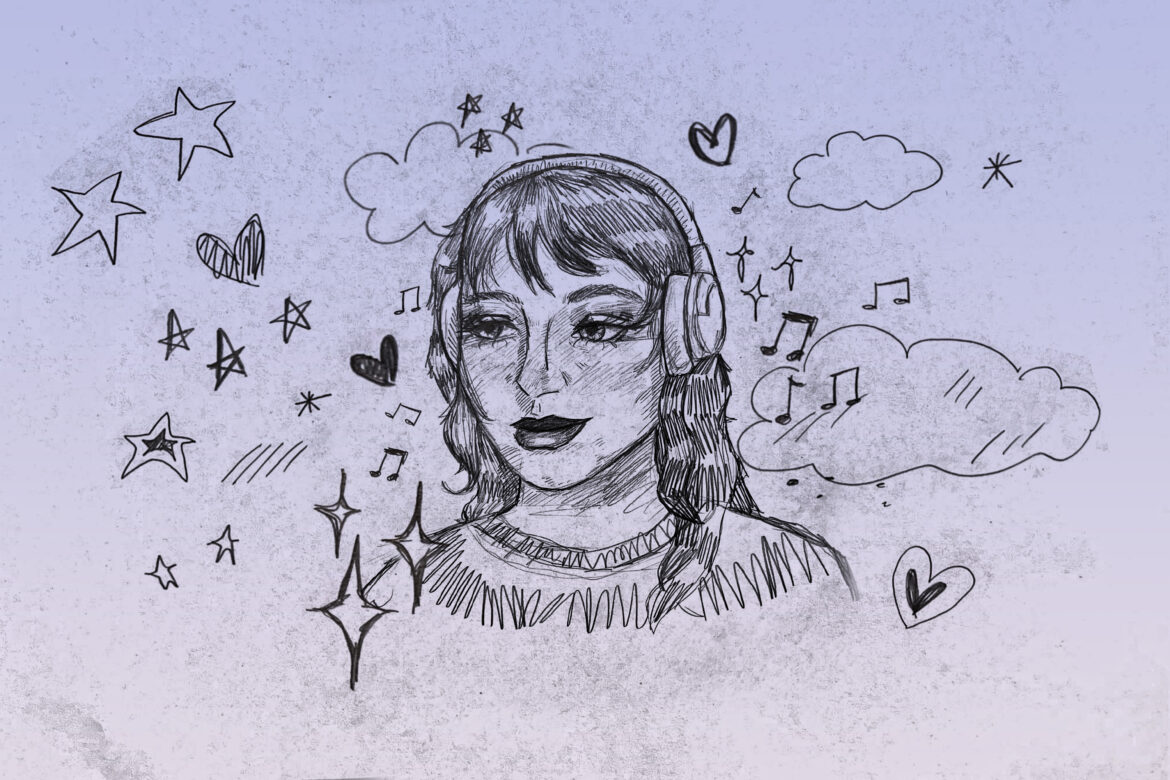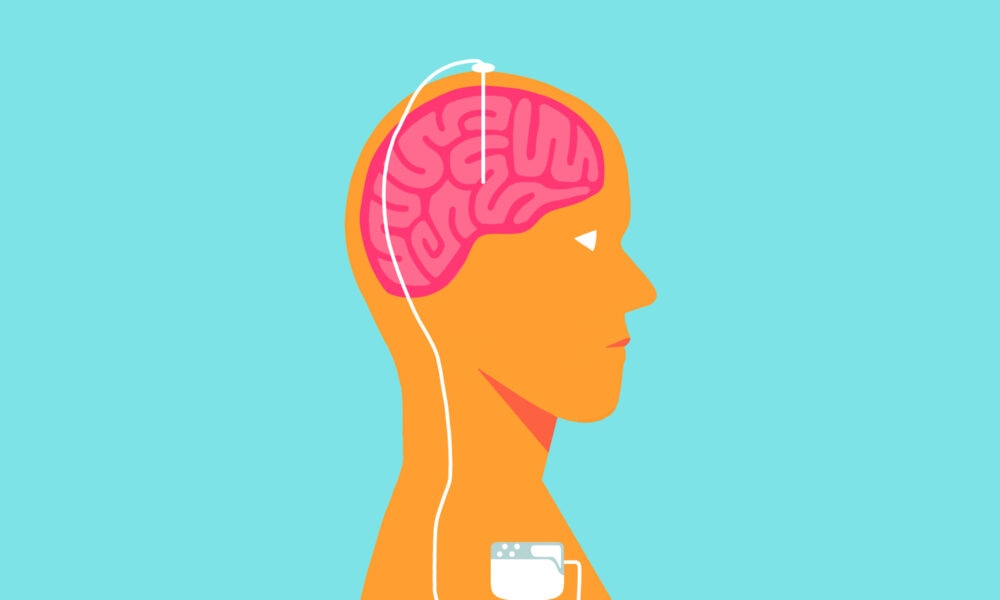Illustration by Jane Montalto
In June 2022, alternative indie pop band MUNA released their third album, MUNA. The album is their first under Phoebe Bridgers’ label, Saddest Factory Records. “Life’s so fun, life’s so fun/Got my miniskirt and my rollerblades on,” lead vocalist Katie Gavin belts in the chorus of lead single “Silk Chiffon.”
This is in stark contrast to the visceral lyrics listeners are privy to in songs like “Crying on the Bathroom Floor,” from MUNA’s 2017 album, About U. “Give me your disrespect/Give me your pain and loneliness,” the band laments.
MUNA reinvented themselves with MUNA — where there was once an angry, politically charged queer band teetering on EDM beats, now there is unadulterated sass, fun and glee associated with the trio.
MUNA’s newfound identity in their recent album is not an isolated incident.
Take Lorde’s uplifting psychedelic pop record Solar Power. The New Zealand singer described the 2021 release as her “weed album.” With dreamy vocals over a groovy, beachy instrumental, a verse from the title track sums up her transition from poignant Melodrama to her newest record:
Forget all of the tears that you’ve cried
It’s over (over, over, over)
It’s a new state of mind
Are you coming, my baby?
Most notable of the new wave pop projects is Taylor Swift’s Midnights, the revitalized and bejeweled love child of her former records, 1989 and Reputation. Swift’s vocals are huskier — Lana Del Rey-esque — her lyrics are slyly sexual and her wine of choice is cheap rosé. Now 32, her work is more mature, but just as jovial. On fan-favorite “Karma,” Swift sings in layered vocals:
Sweet like honey
Karma is a cat
Purring in my lap ‘cause it loves me
Flexing like a goddamn acrobat
Me and karma vibe like that
MARINA, formerly known as Marina and The Diamonds, has also matured. Her 2012 persona was adorned with hearts, bubblegum and pinup curls whilst singing bleak tales of teendom — think eating disorders, male validation, profound loneliness, etc. — on Electra Heart. On the other hand, MARINA now sports fruit and flowers in her music’s imagery, whilst searching for her divine feminine through anthemic tracks like “Man’s World,” from her latest album Ancient Dreams In A Modern Land. Both fun and empowering, she sings like a siren somewhere between a floaty soprano and her throaty, lower register:
I’m a strawberry soda, raise my lashes to heaven
Stars in my hair running like a waterfall
I don’t wanna live in a man’s world anymore.
After years of melancholic records dominating the charts such as SZA’s Ctrl, Lana Del Rey’s Norman fucking Rockwell!, FKA Twigs’ MAGDALENE and Taylor Swift’s Folklore, why are these light-and-sweet projects having a long-awaited return now?
Let’s start with what led us astray from the early ‘00s and ‘10s pop and led us towards the yearnful records that prevailed from 2016 to 2020.
Radio pop’s downward spiral began with an attitude towards the general mainstream that festered on social media and grew over time. Being “basic” — enjoying cultural trends like pop music — was frowned upon.
For a long time after its 2010 release, Katy Perry’s Teenage Dream felt like a guilty pleasure to me, as did a lot of similar music, like Lady Gaga’s The Fame, or Britney Spears’ Circus. At the end of the year, they were some of my top artists. However, when people asked who my favorite artists were, I’d list names far from Katy Perry.
The Smiths. Soundgarden. System of a Down. Stone Temple Pilots. Those were the artists I named instead. And don’t get me wrong — I love these bands. But my so-called guilty pleasures weren’t woven into that list for a reason.
Internalized misogyny is characterized by experiencing sexist thoughts or enacting sexist behaviors upon oneself. A common symptom is the infamous “I’m not like other girls” mentality. By streaming some of the light-hearted, chart-topping albums I mentioned, I was exactly like other girls, but I didn’t want others to know. I wasn’t alone in this thought process either.
Following a career-changing controversy involving Kanye West in 2016, Swift’s reputation — the title of the record she released one year later — was tarnished. She experienced a mass resurgence of supporters with the release of her folk sister albums, Folklore and Evermore. Intricate, wistful lyrics characterize the duo. These were her first alternative albums after over a decade of country and pop releases.
Suddenly, it was cool to be a Swiftie again.
Girls like me, who had once shied away from listening to Swift’s discography — at least openly — were now able to express their admiration of the pop star without fear of the word “basic.”
Alongside Swift’s near-abandonment of pop, COVID-19 ensued. She released these albums in July and December of 2020. Not only was sweet, poppy music not “in” anymore, it was almost distasteful in the face of a worldwide lockdown.
A 2021 study found that depressive symptoms in U.S. adults tripled immediately following quarantine. Naturally, musical themes of isolation and melancholy accompanied mid-pandemic releases. Because of their relatability, woeful records dominated the charts, bumping bubblegum pop down several notches.
Now, in 2022, most COVID-19 restrictions have been lifted, though not without contention. The reintegration of normalcy and social gatherings into everyday life has remedied the feelings of loneliness and depression that came with quarantine.
“Bag on my side ‘cause I’m out till dawn / Keeping it light like silk chiffon,” Katie Gavin sings. It’s safe to say that people are eager to get back outside and embrace the sensuality of life, as upbeat records like those of MUNA, Swift, MARINA and many more pioneer the era of post-lockdown music.
While Lorde’s Solar Power perfectly fit the post-lockdown music era themes, it was arguably released too soon for most. By June 2020, New Zealand announced that there were zero existing COVID-19 cases across the nation. Upon the album’s August 2021 release, the rest of the world was still riddled with the virus.
Thus, New Zealand-born Lorde’s refreshing new album was not nearly as relatable as Pure Heroine or Melodrama. In fact, Melodrama, sold more than twice as many copies as Solar Power, which was met with harsh criticism upon release.
Internalized misogyny, another contributor to the stifling of pop music in the mainstream, still exists. It evolves with time, festering itself in social media discourse and trends. However, as the phrase “internalized misogyny” becomes more commonly known, the phenomenon shrinks.
By naming and understanding the diagnosis, it becomes easier to detect one’s own symptoms. I don’t remember where I first heard the words “internalized misogyny” used, but I do remember coming to the understanding that I didn’t like half of the things I told myself I did — I’d just been told for so long that mainstream, usually feminine hobbies and interests were “basic.”
When I was 13, I was deemed a “feminazi,” amongst a number of other names, by boys at my school as I expressed my early support for the fourth wave feminism that was beginning to flood mainstream discourse. I doted on this as I got older. Over time, I had unknowingly become less outspoken at 17 than I was at 13.
It took years to come to the conclusion that if I listened to the external voices reprimanding me for being so much as akin to femininity, internalized misogyny would follow. When I did stop listening, though, I felt a weight come off my shoulders.
The revitalized pop beats of the somewhat-post-COVID era are not as ubiquitously joyful as the revered dance tunes of the ‘00s, but there is an overarching theme: following the light at the end of the tunnel.




Comments are closed.